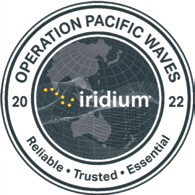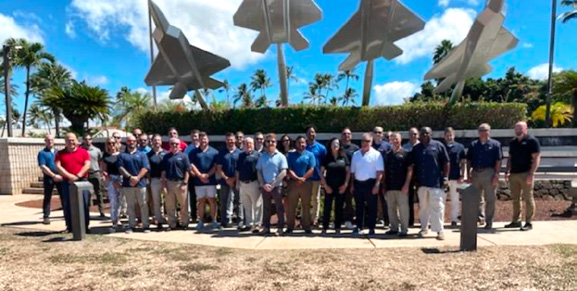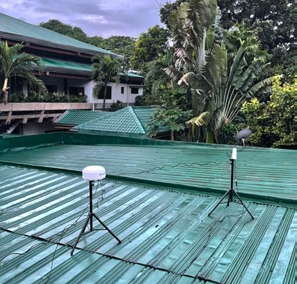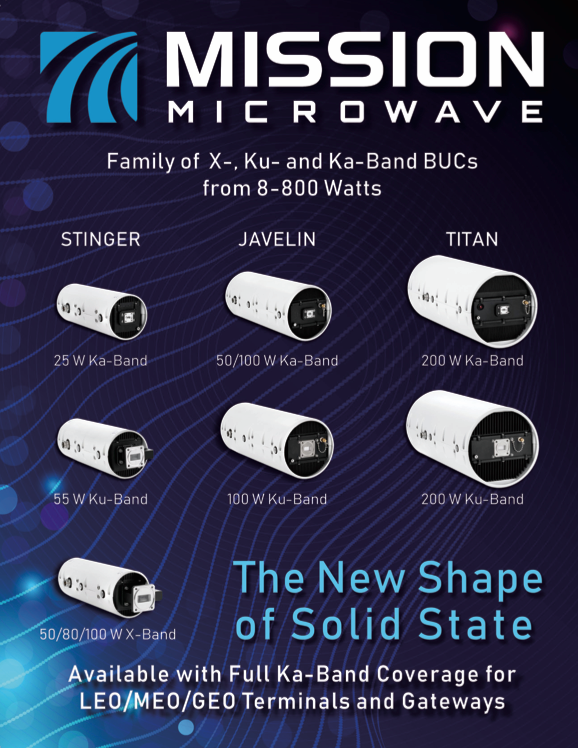With increased geopolitical interest and rising ecological threats in the Indo-Pacific region, the need for reliable connectivity is at an all-time high. Currently, satellite communications (SATCOM) is the ideal solution for delivering reliable Beyond Visual Line of Sight (BVLOS) connectivity to the most remote corners of the Indo-Pacific. As the only network that provides coverage to the entire planet, Iridium remains the pre-eminent leader of enabling weather-resilient SATCOM to the region.

In September of 2022, the company conducted a field demonstration of Iridium® and Iridium Connected® technology called Operation Pacific Waves (OPW). Iridium technology partners in coordination with existing customers like the U.S. Department of Defense, coalition partners, and scientific research organizations exhibited Iridium’s weather-resilient SATCOM technology on-base, on-the- move and remotely from the field in the Indo-Pacific and other remote locations around the globe.
Iridium’s Vice President of Government Solutions, Ken Flowers, explains Iridium’s important and unique role in enabling reliable communications in the Indo-Pacific and shares highlights from Operation Pacific Waves.
Mr. Flowers, why is reliable SATCOM connectivity in the Indo-Pacific important?

Ken Flowers
Ken Flowers
As home to more than half of the world’s population, almost two-thirds of the world’s economy, and some of the world’s largest militaries, the growing Indo-Pacific region continues to play a critical role globally. 40 countries and economies with vast biogeographic landscapes are spread across the tropical waters of the Indian Ocean and the western and central Pacific Ocean to the seas connecting the two near Indonesia.
Even today, parts of the Indo-Pacific are some of the most challenging places to find reliable terrestrial connectivity. Currently, Iridium is the best suited SATCOM provider to deliver reliable connectivity in the Indo-Pacific, due to the company’s orbital location in Low Earth Orbit (LEO), L-band spectrum and crosslinked network architecture enabling robust and weather-resilient coverage across the entire planet.
Indonesia is a clear example of this. As the largest archipelago in the world, Indonesia is comprised of five major islands and more than 17,500 smaller islands, of which about 6,000 are inhabited. The size and scope of its territory makes building and maintaining cellular or land-mobile radio (LMR) network infrastructure expensive, challenging and impractical. To overcome those communication challenges, the Indonesian government adopted Iridium® Push-to-Talk (PTT) devices for reliable real-time communications on land, at sea or in the air.

Iridium + Iridium partners during the company’s OPW expedition.
Photo courtesy of Iridium
Would you tell us more about the Iridium network’s capabilities and why they are unique?
Ken Flowers
For the last 20 years, Iridium has been the leader in global connectivity, providing our narrowband services to people and organizations in the Indo-Pacific and around the world. Due to the unique architecture of the Iridium network, we are able to deliver a reliable and strong SATCOM connection to the most remote territories in the Indo-Pacific, even through inclement tropical weather. Our crosslinked satellites in LEO are always in communication with one another, converging at the poles as they rotate around the Earth, delivering a strong signal to locations that typically lack reliable coverage.
In addition to our unique network architecture and polar orbit, our location in LEO delivers a low-latency connection, making real-time communications possible. Our L-band spectrum allocation delivers a weather-resilient connection that is ideal for those operating in the Indo-Pacific, widely known as the region most exposed to natural disasters.
In addition to delivering our traditional narrowband services, such as messaging and voice calling, we are providing our broadband services with Iridium Certus®. The availability of multiple Iridium Certus speed classes brings additional capabilities, such as the ability to enable compressed video, an important tool for search and rescue organizations that rely on BVLOS technology to conduct both civilian and military rescue missions. Essentially, we can provide the “eyes” that can investigate the most remote areas.
What was the main purpose of OPW and was it a success?
Ken Flowers
Following the success of Operation Arctic Lynx (OAL), the main purpose of OPW was to exercise our capabilities to the Indo-Pacific for all who operate in the region, and in that regard, it was a complete success. Given the company’s long history, Iridium is often thought of as just a satellite phone company. OPW was a great opportunity to expose the Indo-Pacific region to various other solutions like PTT, unattended sensors, trackers, Iridium Certus and video compression and more.
Iridium’s truly global coverage provides the Combatant Command, its subordinate component commands and its coalition partners a critical on-the-move L-band resiliency for its Joint All-Domain Command and Control (JADC2) Primary, Alternate, Contingency and Emergency (PACE) communications plan/architecture. We were able to demonstrate to key military organizations, including the United States Air Force, Coast Guard, Army and National Guard, what our upgraded network is capable of providing.
The Iridium Certus Connected® Thales MissionLINK™ in the Philippines set up so those inside the conference room could watch live Iridium Certus video channels. Image is courtesy of the company.
Can you share any findings or highlights from the expedition?
Ken Flowers
In addition to demonstrating the strength of our SATCOM services and solutions within the Indo-Pacific region, we were able to show participants our full global scope. During OPW, we not only connected with those in the Indo-Pacific, but we were able to facilitate voice, data and video calls with colleagues in Antarctica and Colorado Springs during a variety of weather conditions, truly highlighting the power of our services.
A major highlight was live video sent over Iridium Certus. This included a telemedicine use-case over the Iridium Certus Connected Thales MissionLINK broadband terminal using the AnsuR Asmira software. Multiple live video channels were sent simultaneously from Japan, Philippines, South Africa (airborne commercial ISR 3,200 feet elevation), Hawaii, Antarctica (South Pole Station) and northwest USA (airborne platform 34,000 feet elevation). Successful Iridium Certus video shows that Iridium services are an important element of any JADC2 PACE plan ensuring connectivity to the data fabric and providing critical information for leader decision-making.
Did any Iridium technologies perform better over others?
Ken Flowers
All of our services performed very well, but there were a few standout moments with our tracking capabilities. During OPW, Iridium and its partners successfully demonstrated a variety of technologies to open the customer and user’s eyes as to how far Iridium has come since the days of the firm’s first-generation constellation 2.4 kbps narrowband capabilities. You can learn more about the specific Iridium technologies from Iridium partners at this direct infolink...

Are there plans for future Indo-Pacific demonstrations similar to OPW?
Ken Flowers
Given the growing importance of the Indo-Pacific region, our team is continuing the efforts of OPW. This year, we are going out in the field again to put Iridium Connected equipment into the hands of the users. We know it’s important to let the user “kick the tires” and use the equipment in line with unit Concept of Operations (CONOPS). We look forward to leading and supporting additional exercises in the future that demonstrate the breadth of our worldwide services.

For additional Iridium network,information, access this direct link...
To learn more about Operation Arctic Lynx (OAL), revisit MilsatMagazine’s conversation with Iridium in the September 2021 issue:
The Importance of Reliable SATCOM in the Polar Regions



